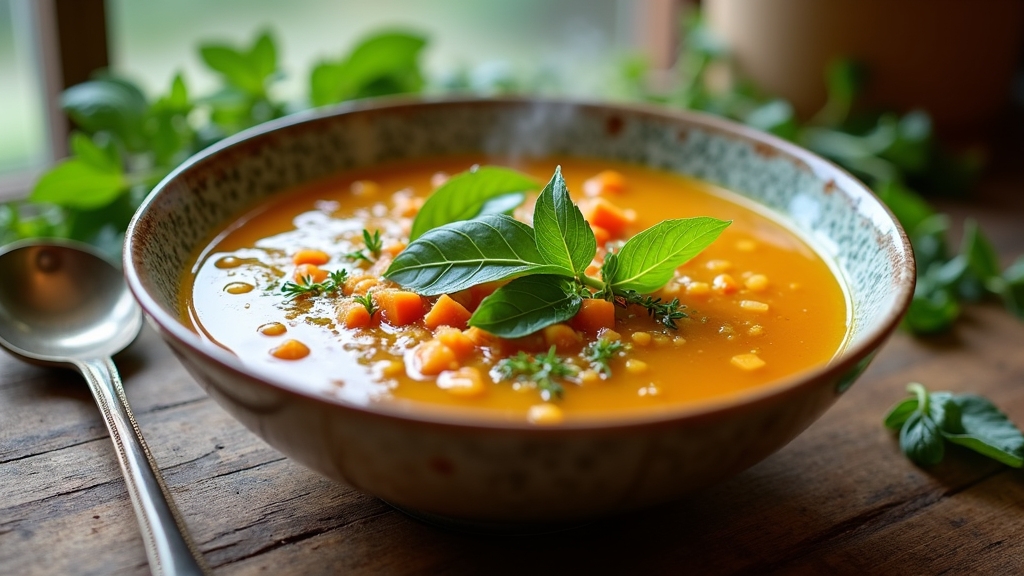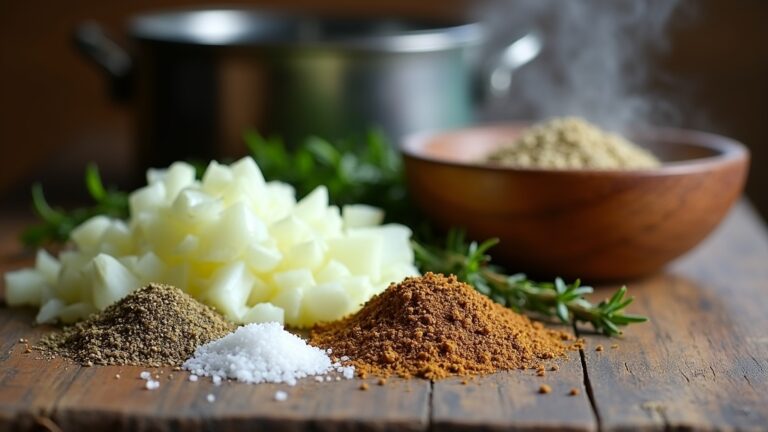Homemade Soup Recipe
Homemade soup is pure comfort for me, transforming fresh veggies and broth into a nourishing meal. I start by finely chopping vegetables, then simmer them in flavored broth for at least 30 minutes, letting those rich aromas fill my kitchen. I love to play with seasonings—salt, pepper, and herbs—finding the perfect balance. Finally, blending it smooth and garnishing with fresh herbs really lifts the dish. There’s so much more to explore about crafting the perfect soup!
Contents
History
When I think about the history of soup, I can’t help but be fascinated by its evolution across cultures and centuries. Ancient soups were often simple concoctions, made by boiling grains, vegetables, or meats in water. These early recipes held immense cultural significance; they provided nourishment and warmth, often shared among families and communities. As civilizations advanced, so did the complexity of soups, reflecting local ingredients and culinary techniques. From the hearty stews of the Middle Ages to the delicate broths of Asian cuisines, each variation tells a story of the people who created it. Soup’s adaptability has allowed it to thrive, continuously innovating while remaining a comforting staple in our diets, connecting us to our past and each other.
Recipe
Homemade soup is one of the most comforting dishes you can prepare, perfect for warming up on a chilly day or simply nourishing your soul. The beauty of making soup at home is that you can customize it to your taste, using fresh ingredients and flavors that you love. Whether you’re looking for a creamy tomato basil, a hearty vegetable, or a classic chicken noodle, this recipe will guide you through the process of creating a delicious homemade soup from scratch.
Homemade soup warms the soul and allows you to personalize flavors with fresh ingredients, creating comforting meals tailored to your taste.
In addition to being a delightful meal, soup is also a fantastic way to use up any leftover vegetables or meat you might have in your fridge. The simmering of ingredients allows the flavors to blend beautifully, creating a dish that is not only satisfying but also healthy. Follow this straightforward recipe to whip up a pot of homemade soup that will surely impress your family and friends.
Ingredients:
- 2 tablespoons olive oil
- 1 onion, diced
- 2 carrots, diced
- 2 celery stalks, diced
- 3 garlic cloves, minced
- 4 cups vegetable or chicken broth
- 1 can (14.5 ounces) diced tomatoes
- 1 teaspoon dried basil
- 1 teaspoon dried oregano
- Salt and pepper to taste
- 2 cups fresh or frozen vegetables (e.g., green beans, peas, corn)
- Optional: 1 cup cooked protein (chicken, beans, or tofu)
- Fresh parsley for garnish
In a large pot, heat the olive oil over medium heat. Add the diced onion, carrots, and celery, sautéing until the vegetables are tender, about 5-7 minutes. Stir in the minced garlic and cook for another minute until fragrant. Pour in the broth and add the diced tomatoes, dried basil, oregano, salt, and pepper. Bring the mixture to a simmer and let it cook for about 15 minutes, allowing the flavors to meld. Ultimately, add your choice of fresh or frozen vegetables and any cooked protein, cooking for an additional 5-10 minutes until everything is heated through.
When making homemade soup, feel free to experiment with different herbs and spices to suit your taste. You can also adjust the consistency by adding more broth if you prefer a thinner soup or simmering it longer for a thicker texture. Additionally, don’t hesitate to blend the soup for a creamy texture, or add a splash of cream or a dollop of yogurt for richness. Lastly, serving the soup with a slice of crusty bread or a sprinkle of cheese can elevate your dish even further. Enjoy your homemade creation!
Cooking Steps
When I start making my homemade soup, the first step is to chop fresh vegetables finely, as this really enhances the flavor. I then simmer them in broth, letting all those delicious aromas mingle together. Finally, I add seasoning to taste before blending everything until it’s perfectly smooth, ready for a delightful garnish with fresh herbs.
Step 1. Chop Fresh Vegetables Finely
Chopping fresh vegetables finely is essential for enhancing the flavors of your homemade soup. When I immerse myself in this step, I embrace various chop techniques that transform my ingredients into vibrant, bite-sized pieces. Whether I’m dicing onions, mincing garlic, or slicing carrots, the key is consistency. Uniform pieces not only cook evenly but also release their flavors more effectively, allowing the broth to absorb those delicious vegetable benefits. I love experimenting with my knife skills, turning mundane prep into a creative process. Each chop builds excitement for the final dish, as the scents fill my kitchen. Remember, the finer you chop, the more integrated and flavorful your soup will be. Let’s elevate your soup game!
Step 2. Simmer in Broth for Flavor
To truly release the rich flavors of your soup, simmering the chopped vegetables in broth is a game changer. Choosing the right broth types can elevate your soup experience, offering unique flavor enhancement that transforms every spoonful. As I let my veggies mingle in the broth, magic happens. The aromas fill my kitchen, creating an inviting atmosphere.
Here are a few tips I’ve discovered:
- Use homemade chicken or vegetable broth for depth.
- Experiment with miso or bone broth for added richness.
- Allow a gentle simmer for at least 30 minutes.
- Stir occasionally to keep flavors well blended.
- Taste as you go to monitor the evolving flavors.
This step is essential for crafting a truly delicious soup.
Step 3. Add Seasoning to Taste
As the simmering broth fills the air with warmth, I can’t help but reach for my spice rack, ready to elevate the flavors of my soup. Each seasoning blend I choose will add a unique twist to the dish, transforming it into something extraordinary. I start with salt and pepper to enhance the base, then I experiment with herbs like thyme and rosemary to create a comforting aroma. A pinch of smoked paprika introduces depth, while a dash of chili flakes adds a gentle kick. I taste as I go, fine-tuning the flavor profiles until they harmonize perfectly. This step is where the magic happens, turning simple ingredients into a soulful bowl of goodness that warms both body and spirit.
Step 4. Blend Until Smooth
With a steady hand, I carefully ladle the simmered soup into my blender, enthusiastic to transform the chunky mixture into a velvety smooth delight. As I secure the lid, I can almost taste the rich flavors melding together. I pulse the blender, using various blending techniques to achieve that perfect smooth texture.
- Start on a low setting to avoid splatters.
- Gradually increase the speed for even blending.
- Blend in batches if the soup is too full.
- Scrape down the sides for consistency.
- Taste test as you go for seasoning.
In just a few moments, I’m rewarded with a silky soup, ready for the next steps in my culinary adventure. It’s a game changer!
Step 5. Garnish With Fresh Herbs
Once the soup’s silky texture has been achieved, I’m enthusiastic to elevate its flavor and presentation by garnishing it with fresh herbs. Fresh herbs like basil, parsley, or cilantro not only add vibrant color but also pack a punch of flavor and numerous herb benefits, such as antioxidants and vitamins. I typically use a few garnish techniques: finely chop the herbs for a delicate sprinkle, or create a herb oil by blending them with olive oil for a luxurious drizzle. This not only enhances the soup’s appearance but also infuses it with aromatic richness. Experimenting with different herbs can transform your dish, keeping it innovative and exciting, ensuring each bowl is a delightful experience for your taste buds.
Nutritional Guide
While I love the warmth and comfort of a steaming bowl of homemade soup, I also appreciate the nutritional benefits it can offer. When preparing soup, I pay attention to dietary considerations, ensuring a balance of flavors and nutrients. Here’s a quick nutritional guide to keep in mind:
| Nutrient | Benefits |
|---|---|
| Protein | Builds and repairs tissues |
| Fiber | Aids digestion, promotes satiety |
| Vitamins A & C | Supports immune function |
Incorporating vegetables, lean proteins, and wholesome grains into my soups not only enhances flavor but also boosts the overall nutritional profile. So, let’s get creative with ingredients while nourishing our bodies with every spoonful!
Final Thoughts
Creating homemade soup goes beyond just nourishment; it’s an experience that brings joy and warmth into our kitchens. Each spoonful tells a story, whether it’s a cherished family tradition or a new recipe experiment. The soup benefits are abundant, not just for our bodies but for our souls, as we gather around the table to share and connect.
- It fosters creativity with endless flavor combinations.
- It’s a canvas for seasonal ingredients, promoting sustainability.
- It strengthens family bonds through shared cooking experiences.
- It warms the heart, perfect for cold days or when feeling under the weather.
- It invites innovation, encouraging culinary exploration.
Frequently Asked Questions
Can I Freeze Leftover Homemade Soup?
Absolutely, I freeze leftover soup! I use airtight containers for soup storage, leaving room for expansion. For freezing tips, cool it first, then label with dates. You’ll savor those flavors later—trust me, it’s worth it!
What Are Some Common Soup Thickening Agents?
When I thicken my soups, I often use a cornstarch slurry for a quick fix or a roux preparation for a richer texture. Both methods elevate the dish, adding depth and satisfaction to every spoonful.
How Long Does Homemade Soup Last in the Fridge?
Just like a cozy blanket on a chilly day, homemade soup warms the soul. For soup storage, I find it stays fresh in the fridge for about three to four days—safety first, always!
Can I Use Vegetable Scraps for Soup?
Absolutely, I love using vegetable scraps for soup! They add depth and flavor while reducing waste. The soup benefits from all those nutrients, making every bowl delicious and eco-friendly. It’s a win-win for innovative cooking!
What Kitchen Tools Do I Need to Make Soup?
Making soup’s the easiest culinary magic you’ll ever conjure! For soup making essentials, I recommend a sturdy pot, sharp knives, and a trusty immersion blender. These kitchen gadget recommendations will transform your ingredients into a delightful masterpiece!
Conclusion
As I savor the warmth of my homemade soup, I can’t help but think about the contrast between the chaos of the outside world and the comfort of my kitchen. Each spoonful brings a blend of flavors that tell a story—of tradition, creativity, and love. Whether it’s a simple broth or a hearty vegetable medley, this recipe is a reminder that amidst life’s hustle, there’s always time to create something nourishing and delightful. So, grab your ingredients and let’s make some magic!











